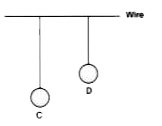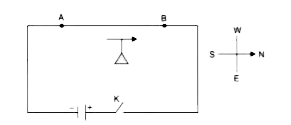Complete Solutions to SECTION-II of chapter QUESTION PAPER-2019 of Class 10 book with complete answers and questions
| Class 10 | PHYSICS |
| Chapter | QUESTION PAPER-2019 |
| SELINA PUBLICATION | SECTION-II |
| Number Of Questions | 42 |
| Academic Year | 2023-24 |
A body of mass 10 kg is kept at a height of 5 m. It is allowed to fall and reach the ground.
What is the total mechanical energy possessed by the body at the height of 2 m assuming it is a frictionless medium ?
View SolutionA body of mass 10 kg is kept at a height of 5 m. It is allowed to fall and reach the ground.
What is the kinetic energy possessed by the body just before hitting the ground? (Take g = `10m//s^(2)`).
View SolutionA uniform meter scale is in equilibrium as shown in the diagram :

Calculate the weight of the meter scale.
View SolutionA uniform meter scale is in equilibrium as shown in the diagram :

Which of the following options is correct to keep the ruler in equilibrium when 40 gf wt is shifted to 0 cm mark? F is shifted towards 0 cm. Or F is shifted towards 100 cm.
View SolutionThe diagram alongside shows a pulley arrangement :
Copy the diagram and mark the direction of tension on each strand of the string.

View SolutionThe diagram alongside shows a pulley arrangement :
What is the velocity ratio of the arrangement ?

View SolutionThe diagram alongside shows a pulley arrangement.
(a) Name the pulleys A and B.
(b) In the diagram, mark the direction of tension on each strand of string.
(c) What is the purpose of the pulley B?
(d) If the tension is T, deduce the relation between
T and E
(e) What is the velocity ratio of the arrangement ?
(f) Assuming that the efficiency of the system is 100%, what is the mechanical advantage ?
View SolutionThe diagram alongside shows a pulley arrangement :
If the free end of the string moves through a distance x, find the distance by which the load is raised.

View SolutionHow does the angle of deviation formed by a prism change with the increase in the angle of incidence ?
Draw a graph showing the variation in the angle of deviation with the angle of incidence at a prism surface.
View SolutionA virtual, diminished image is formed when an object is placed between the optical centre and the principal focus of a lens.
Name the type of lens which forms the above image.
View SolutionA virtual, diminished image is formed when an object is placed between the optical centre and the principal focus of a lens.
Draw a ray diagram to show the formation of the image with the above stated characteristics.
View SolutionAn object is placed at a distance 24 cm in front of a convex lens of focal length 8 cm.
(i) What is the nature of the image so formed ?
(ii) Calculate the distance of the image from the lens.
(iii) Calculate the magnification of the image.
View SolutionAn object is placed at a distance 24 cm in front of a convex lens of focal length 8 cm.
Calculate the distance of the image from the lens.
View SolutionAn object is placed at a distance 24 cm in front of a convex lens of focal length 8 cm.
(i) What is the nature of the image so formed ?
(ii) Calculate the distance of the image from the lens.
(iii) Calculate the magnification of the image.
View SolutionIt is observed that during march-past we hear a base drum distinctly from a distance compared to the side drums.
Name the characteristics of sound associated with the above observation.
View SolutionIt is observed that during march-past we hear a base drum distinctly from a distance compared to the side drums.
Name the characteristics of sound associated with the above observation.
View SolutionA pendulum has a frequency of 4 vibrations per second. An observer starts the pendulum and fires a gun simultaneously. He hears the echo from the cliff after 6 vibrations of the pendulum. If the velocity of sound in air is 340 m/s, find the distance between the cliff and the observer.
View SolutionTwo pendulums C and D are suspended from a wire as shown in the figure given below. Pendulum C is made to oscillate by displacing it from its mean position. It is seen that D also starts oscillating.
Name the type of oscillation, C will execute.

View SolutionTwo pendulums C and D are suspended from a wire as shown in the figure given below. Pendulum C is made to oscillate by displacing it from its mean position. It is seen that D also starts oscillating.
Name the type of oscillation, D will execute.

View SolutionTwo pendulums C and D are suspended from a wire as shown in the figure given below. Pendulum C is made to oscillate by displacing it from its mean position. It is seen that D also starts oscillating.
If the length of D is made equal to C then what difference will you notice in the oscillations of D?

View SolutionTwo pendulums C and D are suspended from a wire as shown in the figure given below. Pendulum C is made to oscillate by displacing it from its mean position. It is seen that D also starts oscillating.
What is the name of the phenomenon when the length of D is made equal to C ?

View SolutionWrite one advantage of connecting electrical appliances in parallel combination.
View SolutionWhat characteristics should a fuse wire have?
View SolutionWhich wire in a power circuit is connected to the metallic body of the appliance ?
View SolutionThe Fig. below shows a dual control switch circuit use to light a bulb.

Complete the circuit so that bulb is switched on.
View SolutionThe Fig. below shows a dual control switch circuit use to light a bulb.

Mark the supply terminals with L and N to indicate live and neutral wires.
View SolutionThe diagram alongside shows a circuit with the key k open. Calculate :

the resistance of the circuit when the key k is open.
View SolutionThe diagram alongside shows a circuit with the key k open. Calculate :

the current drawn from the cell when the key k is open.
View SolutionThe diagram alongside shows a circuit with the key k open. Calculate :

the resistance of the circuit when the key k is closed.
View SolutionThe diagram alongside shows a circuit with the key k open. Calculate :

the current drawn from the cell when the key k is closed.
View SolutionDefine Calorimetry.
View SolutionName the material used for making a Calorimeter.
View SolutionWhy is a Calorimeter made up of thin sheets of the above material.
View SolutionThe melting point of naphthalene is `80^(@)C` and the room temperature is `30^(@)C`. A sample of liquid naphthalene at `100^(@)C` is cooled down to the room temperature. Draw a temperature time graph to represent this cooling. In the graph, mark the region which corresponds to the freezing process.
View Solution104 g of water at `30^@`C is taken in a calorimeter made of copper of mass 42 g. When a certain mass of ice at 0°C is added to it, the final steady temperature of the mixture after the ice has melted, was found to be `10^@`C. Find the mass of ice added. [Specific heat capacity of water = 4.2 J `g^(-1)""^@ C^(-1)`, Specific latent heat of fusion of ice = 336 J `g^(-1)`, Specific heat capacity of copper `= 0.4 Jg^(-1) ""^@ C^(-1)`].
View SolutionDraw a neat labelled diagram of an A.C. generator.
View SolutionDefine nuclear fission.
View SolutionRewrite and complete the following nuclear reaction by filling in the atomic number of Ba and mass number of Kr :
`""_(92)^(235)U+""_(0)^(1)nto""_(...)^(144)Ba+""_(36)^(...)Kr+3""_(0)^(1)n+"Energy"`
View SolutionThe diagram below shows a magnetic needle kept just below the conductor AB which is kept in North South direction.

In which direction will the needle deflect when the key is closed ?
View SolutionThe diagram below shows a magnetic needle kept just below the conductor AB which is kept in North South direction.

Why is the deflection produced ?
View SolutionThe diagram below shows a magnetic needle kept just below the conductor AB which is kept in North South direction.

What will be the change in the deflection of the magnetic needle is taken just above the conductor AB ?
View SolutionThe diagram below shows a magnetic needle kept just below the conductor AB which is kept in North South direction.

Name one device which works on this principle.
View Solution
SECTION-II questions and complete solutions for chapter QUESTION PAPER-2019 of SELINA PHYSICS (ENGLISH) of Class 10